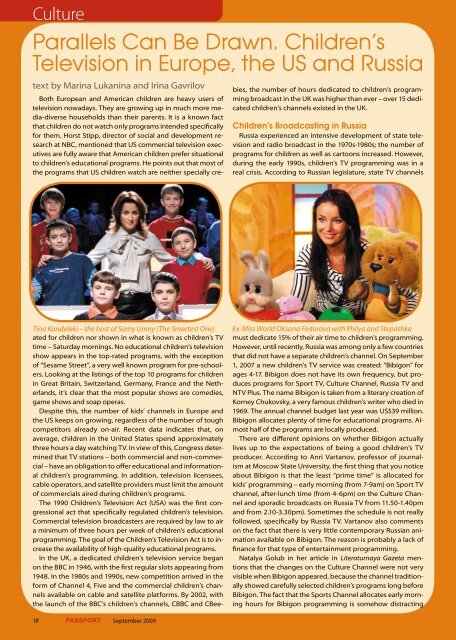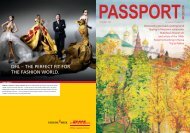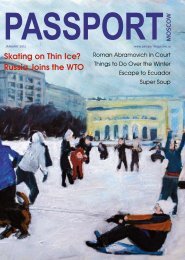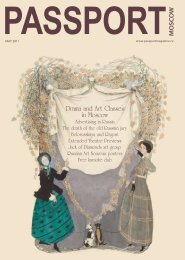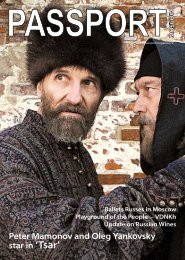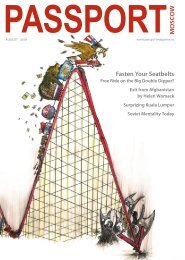Post-Perestroika Warrior - Passport magazine
Post-Perestroika Warrior - Passport magazine
Post-Perestroika Warrior - Passport magazine
Create successful ePaper yourself
Turn your PDF publications into a flip-book with our unique Google optimized e-Paper software.
Culture<br />
Parallels Can Be Drawn. Children’s<br />
Television in Europe, the US and Russia<br />
text by Marina Lukanina and Irina Gavrilov<br />
Both European and American children are heavy users of<br />
television nowadays. They are growing up in much more media-diverse<br />
households than their parents. It is a known fact<br />
that children do not watch only programs intended specifically<br />
for them. Horst Stipp, director of social and development research<br />
at NBC, mentioned that US commercial television executives<br />
are fully aware that American children prefer situational<br />
to children’s educational programs. He points out that most of<br />
the programs that US children watch are neither specially cre-<br />
ated for children nor shown in what is known as children’s TV<br />
time – Saturday mornings. No educational children’s television<br />
show appears in the top-rated programs, with the exception<br />
of “Sesame Street”, a very well known program for pre-schoolers.<br />
Looking at the listings of the top 10 programs for children<br />
in Great Britain, Switzerland, Germany, France and the Netherlands,<br />
it’s clear that the most popular shows are comedies,<br />
game shows and soap operas.<br />
Despite this, the number of kids’ channels in Europe and<br />
the US keeps on growing, regardless of the number of tough<br />
competitors already on-air. Recent data indicates that, on<br />
average, children in the United States spend approximately<br />
three hours a day watching TV. In view of this, Congress determined<br />
that TV stations – both commercial and non-commercial<br />
– have an obligation to offer educational and informational<br />
children’s programming. In addition, television licensees,<br />
cable operators, and satellite providers must limit the amount<br />
of commercials aired during children’s programs.<br />
The 1990 Children’s Television Act (USA) was the first congressional<br />
act that specifically regulated children’s television.<br />
Commercial television broadcasters are required by law to air<br />
a minimum of three hours per week of children’s educational<br />
programming. The goal of the Children’s Television Act is to increase<br />
the availability of high-quality educational programs.<br />
In the UK, a dedicated children’s television service began<br />
on the BBC in 1946, with the first regular slots appearing from<br />
1948. In the 1980s and 1990s, new competition arrived in the<br />
form of Channel 4, Five and the commercial children’s channels<br />
available on cable and satellite platforms. By 2002, with<br />
the launch of the BBC’s children’s channels, CBBC and CBee-<br />
bies, the number of hours dedicated to children’s programming<br />
broadcast in the UK was higher than ever – over 15 dedicated<br />
children’s channels existed in the UK.<br />
Children’s Broadcasting in Russia<br />
Russia experienced an intensive development of state television<br />
and radio broadcast in the 1970s-1980s; the number of<br />
programs for children as well as cartoons increased. However,<br />
during the early 1990s, children’s TV programming was in a<br />
real crisis. According to Russian legislature, state TV channels<br />
Tina Kandelaki – the host of Samy Umny (The Smartest One) Ex-Miss World Oksana Fedorova with Philya and Stepashka<br />
1 September 2009<br />
must dedicate 15% of their air time to children’s programming.<br />
However, until recently, Russia was among only a few countries<br />
that did not have a separate children’s channel. On September<br />
1, 2007 a new children’s TV service was created: “Bibigon” for<br />
ages 4-17. Bibigon does not have its own frequency, but produces<br />
programs for Sport TV, Culture Channel, Russia TV and<br />
NTV Plus. The name Bibigon is taken from a literary creation of<br />
Korney Chukovsky, a very famous children’s writer who died in<br />
1969. The annual channel budget last year was US$39 million.<br />
Bibigon allocates plenty of time for educational programs. Almost<br />
half of the programs are locally produced.<br />
There are different opinions on whether Bibigon actually<br />
lives up to the expectations of being a good children’s TV<br />
producer. According to Anri Vartanov, professor of journalism<br />
at Moscow State University, the first thing that you notice<br />
about Bibigon is that the least “prime time” is allocated for<br />
kids’ programming – early morning (from 7-9am) on Sport TV<br />
channel, after-lunch time (from 4-6pm) on the Culture Channel<br />
and sporadic broadcasts on Russia TV from 11.50-1.40pm<br />
and from 2.10-3.30pm). Sometimes the schedule is not really<br />
followed, specifically by Russia TV. Vartanov also comments<br />
on the fact that there is very little contemporary Russian animation<br />
available on Bibigon. The reason is probably a lack of<br />
finance for that type of entertainment programming.<br />
Natalya Golub in her article in Literaturnaya Gazeta mentions<br />
that the changes on the Culture Channel were not very<br />
visible when Bibigon appeared, because the channel traditionally<br />
showed carefully selected children’s programs long before<br />
Bibigon. The fact that the Sports Channel allocates early morning<br />
hours for Bibigon programming is somehow distracting


